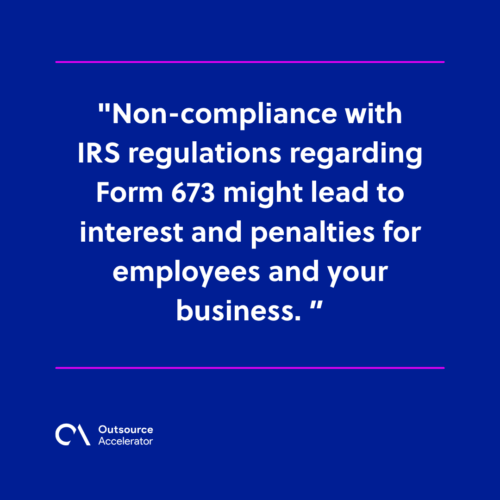Form 673: What you need to know

As a business owner, handling tax forms effectively for financial management is crucial.
One such form that demands attention is Form 673.
This article will cover Form 673, outlining its purpose, who needs to file it, instructions for each section, how to submit it, and the consequences of not complying.
What is Form 673?
See Form 673 (Rev. August 2019)
Form 673 is a document issued by the Internal Revenue Service (IRS) in the United States.
It is officially named “Statement for Claiming Exemption from Withholding on Foreign Earned Income Eligible for the Exclusion(s) Provided by Section 911,”
This form allows eligible employees to reduce or eliminate US federal income tax withholding from their salary.

Who should fill out Form 673?
Employers frequently encounter Form 673. Employees who work abroad or earn income from foreign sources must complete this form.
It reduces or removes the U.S. federal income tax on their earnings.
Employees who meet specific IRS criteria can request reduced withholding by submitting Form 673 to their employer by passing either:
- The bona fide residence test
- The physical presence test in a foreign country
Understanding this form helps employers handle payroll correctly. It ensures they follow the tax rules for their employee’s foreign income.
How to fill out Form 673
Here’s a breakdown into three sections to help employers support their employees through this process:
Section 1: Understanding Form 673
Equip yourself with a comprehensive understanding of Form 673.
Learn its purpose, the required information, and its significance in reducing tax withholding. Familiarize yourself with each section to better assist employees in completing the form.
Section 2: Providing employees’ personal information
Assist employees in accurately providing their details on Form 673. Guide your team to ensure precision, minimizing errors affecting tax withholding.
Section 3: Residency tests and employee eligibility
Help your employees navigate the vital criteria of the bona fide residence and physical presence tests.
Familiarity with these tests is essential in determining eligibility for reduced withholding. Guide how employees can fulfill these tests precisely.
When completing Form 673, it’s essential to be careful and ensure that all sections are filled out correctly and honestly. Mistakes or inaccuracies could lead to processing delays or potential issues with the IRS.
How to submit Form 673
Here’s a concise guide on the submission process:
Step 1: Collect completed forms
Gather completed Form 673 from qualified employees who want less or no US federal income tax from their foreign-earned money.
Ensure all necessary fields are correctly filled out to prevent processing delays.
Step 2: Review for accuracy
Thoroughly review each submitted Form 673 for precision and completeness. Verify that all required information, including personal details and eligibility criteria, is precisely provided.
Address any discrepancies or missing information with the respective employees promptly.
Step 3: Submission to the IRS
As the employer, submit the collected and reviewed Form 673 to the Internal Revenue Service (IRS). Ensure adherence to submission methods and any additional documentation required by the IRS.
Step 4: Maintain records
Retain copies of the submitted Form 673 for your records. This documentation proves compliance with reduced withholding requests. It can also be invaluable during audits or inquiries.
Penalties for not filling out Form 673
As an employer overseeing payroll and tax-related matters, comprehending the penalties for not filing Form 673 is essential.
Here’s an overview of the possible repercussions of failing to file the form correctly or on time:
Increased tax withholding
Failure to submit Form 673 can result in increased tax withholding for employees earning foreign income.
This could lead to:
- Higher deductions from their paychecks
- Impacts on their take-home pay
- Dissatisfaction among your workforce
Potential tax liability
Employees not availing themselves of the reduced withholding via Form 673 might face unexpected tax liabilities. This situation could prompt financial challenges for them and create an unwelcome burden.
Interest and penalties
Non-compliance with IRS regulations regarding Form 673 might lead to interest and penalties for employees and your business.
Over time, these financial consequences can build up, impacting your company’s financial stability and reputation.

Compliance issues
Neglecting Form 673 can result in compliance issues with tax regulations. This might lead to audits or inquiries by tax authorities.
Not complying may cause disruptions to your business operations, and resolving the issues consumes valuable time and resources.
Simplifying Form 673 for your business
Navigating tax forms like Form 673 doesn’t have to be daunting. Understanding its significance and ensuring accurate compliance can streamline payroll processes.
Learn the essentials of Form 673 to manage tax withholding efficiently and keep your business on the right track.
Note that establishing a successful business involves understanding the intricate details of tax compliance. Form 673 is just one piece of the puzzle, but its importance should be noticed.
Stay informed, seek guidance when needed, and ensure compliance to pave the way for a smoother operational journey.







 Independent
Independent




